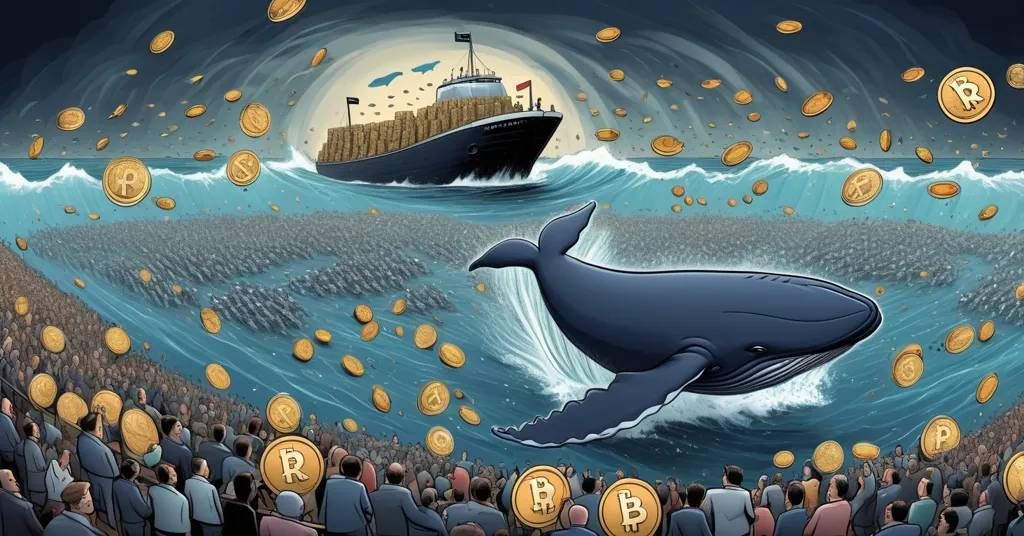XRP Spot ETF News Sparks Market Frenzy: Whales Lead, Retail Follows

XRP Spot ETF Announcement Ignites Market Frenzy: Whales vs. Retail Investors
The crypto market is electric with news of XRP Spot Exchange-Traded Funds (ETFs) on the near horizon, and the reactions from investors paint a revealing picture of strategic divides. Whale investors have been stacking their chips quietly, while retail players are just now jumping on the bandwagon, creating a volatile mix that could redefine XRP’s trajectory.
- Whale Maneuvers: On-chain data highlights large investors accumulating XRP prior to the ETF buzz.
- Retail Rush: Smaller investors flooded in post-announcement, amplifying market swings.
- ETF Countdown: Seven XRP Spot ETFs may launch within 12 days, subject to SEC approval.
Whales Load Up: The Silent Build-Up
Digging into the data, CryptoQuant, a premier on-chain analytics platform, has uncovered a striking pattern in XRP investor behavior surrounding the Spot ETF news. Whale investors—those heavy hitters with massive holdings capable of swaying market tides—were amassing XRP well before any public whispers of ETFs surfaced. This wasn’t blind luck; it’s a calculated play, likely driven by subtle market signals or privileged foresight during a phase when XRP’s price was stuck in a monotonous, sideways drift. These big players positioned themselves to capitalize on an anticipated catalyst, loading up their cannons before the battle even started.
In stark contrast, retail investors—the everyday traders with smaller stakes—only began to act once the ETF announcement hit mainstream channels. Often guided by public sentiment or the dreaded FOMO (Fear Of Missing Out, a common urge to chase trends), their delayed entry has sparked a surge in activity. As CryptoQuant expert Woominkyu points out, this “whales first, retail last” dynamic is a classic signal of shifting tides in the crypto market, often leading to choppy waters ahead. For deeper insights into how XRP holders reacted, check out this detailed analysis of investor behavior before and after the ETF news.
“Whales first, retail last, is typical and frequently indicates a change in the state of the cryptocurrency market.” – Woominkyu, CryptoQuant expert
For clarity, whales are entities or individuals with enormous cryptocurrency holdings, while retail investors are the smaller fish, often trading with personal savings. Spot ETFs, the focal point here, are financial instruments that mirror the price of an asset like XRP, enabling exposure without direct ownership—a game-changer for accessibility, especially for institutional players wary of crypto’s technical complexities.
Retail FOMO: A Recipe for Volatility
The timing of retail engagement couldn’t be more telling. With XRP’s price languishing in a dull rut before the news, whales saw an opportunity to build positions at lower costs. Once the ETF story broke, retail confidence spiked, and smaller investors poured in, chasing the hype. This isn’t just enthusiasm—it’s a textbook setup for market chaos. Late retail entry often ignites erratic price swings, turning a stable asset into a rollercoaster. As history shows, when smaller players rush to follow the yachts, they’re frequently left holding the bag during sudden downturns. It’s a harsh reality of crypto markets: timing is everything, and retail is rarely ahead of the curve.
This volatility isn’t just noise—it’s a risk factor. Without the deep pockets or insider edge of whales, retail investors face exposure to sharp pumps and brutal dumps, especially in a bearish market climate like the one we’re seeing now. While the ETF news has fueled optimism, the unpredictable nature of this influx could spell trouble for those hoping for quick gains from XRP.
XRP Spot ETFs: What’s at Stake?
Turning to the heart of the matter, researcher and host of The Crypto Blitz Show, Ripple Bull Winkle, has revealed that seven XRP Spot ETFs are poised to launch in a tight 12-day window, pending approval from the U.S. Securities and Exchange Commission (SEC). If given the go-ahead, these ETFs will trade on powerhouse exchanges like Nasdaq, CBOE, and NYSE—platforms synonymous with financial legitimacy. This isn’t a minor update; it’s a potential turning point for XRP, opening direct avenues for institutional investment in XRP and possibly reshaping altcoin market trends.
“Institutions aren’t gambling, they’re positioning before the next leg.” – Ripple Bull Winkle, researcher and host of The Crypto Blitz Show
Institutional interest is a critical piece of this puzzle. Unlike retail’s emotional reactions, institutions—think hedge funds and asset managers—move with precision. Their early positioning hints at confidence in XRP’s future, particularly if regulatory clarity emerges. Beyond price impacts, successful ETFs could boost liquidity on exchanges and even strengthen Ripple’s partnerships with financial institutions for cross-border payments, a niche where XRP shines and Bitcoin doesn’t compete. It’s a bridge between crypto’s wild west and traditional finance, something we’ve long advocated for in the push for decentralized disruption.
SEC Crypto Regulations: The Make-or-Break Barrier
Yet, don’t bet the farm just yet. The SEC has a reputation for playing hardball with crypto products, often stalling or rejecting proposals over concerns like market manipulation and investor safety. Bitcoin’s first Spot ETF took years to gain approval in January 2024, after countless setbacks. Ethereum faced similar hurdles before finally getting the nod. XRP, however, carries extra baggage due to a legal battle with the SEC dating back to December 2020, when Ripple Labs was sued for allegedly selling XRP as an unregistered security.
To break this down, a security classification under U.S. law treats a cryptocurrency like a stock or bond, imposing strict rules—think mandatory disclosures and potential penalties. Ripple has notched some wins, like a 2023 court ruling that XRP sales on exchanges aren’t securities, but the case lingers unresolved. An ETF approval would be a massive signal of regulatory acceptance, potentially legitimizing XRP and other altcoins. Conversely, a delay or rejection could cripple momentum, leaving XRP in limbo for years and shaking investor trust. Even if approved, with crypto sentiment still gloomy, don’t expect an unrealistic, rapid price surge that holds steady—it’s not guaranteed.
XRP’s Controversial Edge: Utility vs. Criticism
As someone leaning toward Bitcoin maximalism, I’ll be upfront: altcoins often raise red flags with promises that outstrip reality. XRP, however, holds a unique spot with its focus on cross-border payments, acting as a bridge currency through Ripple’s network—something Bitcoin, with its store-of-value dominance, doesn’t aim to touch. If ETFs launch, this utility could gain traction, especially with institutional backing, carving a niche that complements rather than challenges Bitcoin’s narrative.
Still, XRP isn’t without detractors in the crypto community. Critics point to Ripple’s control over a significant chunk of the supply, raising centralization concerns—a sore point for decentralization purists like myself. There’s also the risk that institutional dominance via ETFs could further concentrate XRP’s holder base, ironically undermining the very freedom and privacy we champion. On the flip side, its practical use case and potential for regulatory clarity via ETFs make a compelling case for relevance. We’re all for innovation, but let’s not swallow hype uncritically—XRP must prove its worth beyond the headlines.
What’s Next for XRP and ETFs?
Looking ahead, the next 12 days could be pivotal. If approved, XRP Spot ETFs might usher in short-term price bumps and bolster community morale, signaling altcoins can coexist with Bitcoin in a maturing market. Compared to Bitcoin and Ethereum ETFs, which brought price stabilization and institutional inflows post-launch, XRP could follow a similar path—though its legal overhang adds uncertainty. Beyond immediate impacts, this could set a precedent for other altcoins seeking mainstream integration, pushing the boundaries of decentralized finance.
Yet, let’s keep our heads on straight. The crypto space is littered with broken dreams fueled by blind optimism. If the SEC stonewalls this, or if retail FOMO spirals into a crash, XRP could face a rough ride. We’re rooting for disruption of the financial old guard, but only if it’s grounded in reality. Stay sharp—hype is a dangerous beast, and the market doesn’t reward naivety.
Key Questions and Takeaways on XRP’s ETF Saga
- Why did whale and retail investors behave so differently around XRP’s ETF news?
Whales acted early, likely using market insights or early signals to accumulate XRP at lower prices, while retail investors reacted to public buzz, jumping in late and fueling volatility. - Can XRP Spot ETFs legitimize a controversial altcoin—or just fuel hype?
Approval could enhance XRP’s credibility and attract institutional capital, stabilizing its market role, though unresolved legal issues and market sentiment remain wildcards. - What risks do retail investors face by entering late after the ETF announcement?
Their delayed action often drives erratic price swings, exposing smaller players to potential losses if the market turns south amid hype-driven trades. - How critical is SEC approval for XRP Spot ETFs, and what obstacles loom?
Approval is essential for launch and investor confidence, but ongoing disputes over XRP’s security status and the SEC’s tough stance on crypto could delay or block the process.



